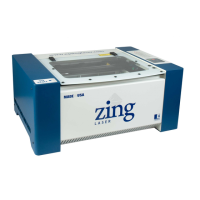Section 13: Material Engraving Techniques
181
Plastic
Plastic Background
Engraving plastics have changed greatly in the past few years. Before lasers, plastic
manufacturers designed plastic for rotary engraving systems. A rotary engraving
system uses a mechanical spinning bit to remove material. Therefore the depth of the
top layer or “cap sheet” was designed to make it easy to rotary engrave. Cap sheet
thickness was approximately .010 inches (0.254 mm) thick and laser engraving was
nearly impossible because by the time you applied enough power to get through the
cap sheet the laser melted and deformed the plastic.
Plastic manufacturers have developed a broad range of plastics that have thinner cap
sheets that are .002 to .003 inches (0.051 mm to 0.076 mm) thick that provide much
better engraving and cutting characteristics. These plastics are commonly referred to
as Micro Laminates; Micro surfaced, or simply laser engravable plastics. These
plastics are generally very easy to engrave with a laser since they all have similar
characteristics.
Because there is such a broad range of plastics it is necessary to experiment to
determine if a particular type of plastic is laser compatible. Different color plastics,
even if they are from the same manufacturer will have unique speed and power
settings. Use the guidelines in this manual as a starting point when determining the
correct speed and power settings. If you do not get acceptable initial results with the
recommended speed and power settings start experimenting by first changing only the
power setting. If adjusting the power setting does not work, start over and adjust only
the speed setting. Once you have acceptable results, record those settings for that
particular plastic so that you do not have to repeat the experimentation process.
Plastic Engraving Techniques
Always remove the clear protective cover layer before engraving.
Once you have the correct speed and power settings you can improve your engraving
results even more by taking the focus lens out of focus (lower the table) by about 1/16
(1.5 mm) of an inch. This technique enlarges the focus beam a little bit and provides
more beam overlap on each pass of the laser. The greater overlap produces a
smoother engraved surface on the plastic and eliminates the grooves that you
sometimes see when engraving plastic.

